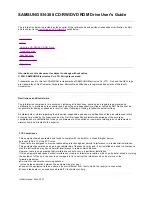
9
Modbus RTU On-Board communications
POWERXL DG1 SERIES VFD
MN040010EN—September 2016 www.eaton.com
Table 7. Modbus RTU/BACnet MS/TP—P20.2, continued
Code
Parameter
Min.
Max.
Unit
Default
ID
Note
P20.2.6
Slave busy
0
589
0 = Not Busy
1 = Busy
P20.2.7
Parity error
0
590
P20.2.8
Slave fault
0
591
P20.2.9
Last fault response
0
592
P20.2.10
Comm timeout modbus RTU
ms
10000
593
P20.2.17
Modbus RTU/BACNet Fault
Response
0
1
0
2516
0 = In Fieldbus Control
1 = in all Control
The parameters of every device must be set before
connecting to the bus. Each parameter must be the same
as the master configuration.
Modbus communication standards
The Modbus protocol is an industrial communications and
distributed control system to integrate PLCs, computers,
terminals, and other monitoring, sensing and control
devices. Modbus is a Master-Slave communications
protocol. The Master controls all serial activity by selectively
polling one or more slave devices. The protocol provides
for one master device and up to 247 slave devices on
a common line. Each device is assigned an address to
distinguish it from all other connected devices.
The Modbus protocol uses the master-slave technique, in
which only one device (the master) can initiate a transaction.
The other devices (the slaves) respond by supplying the
requested data to the master, or by taking the action
requested in the query. The master can address individual
slaves or initiate a broadcast message to all slaves.
Slaves return a message (“response”) to queries that are
addressed to them individually. Responses are not returned
to broadcast queries from the master.
A transaction comprises a single query and single response
frame or a single broadcast frame. The transaction frames
are defined below.
Figure 10. The basic structure of a modbus frame
Master’s
Message
Slave’s
Response
Start
End
Address
Function
Data
CRC
Start
End
Address
Function
Data
CRC
Valid slave device addresses are in the range of 0–247
decimal. The individual slave devices are assigned addresses
in the range of 1–247. A master addresses a slave by placing
the slave address in the address field of the message.
When the slave sends its response, it places its own
address in this address field of the response to let the
master know which slave is responding.
















































